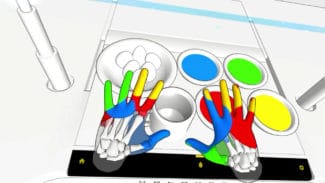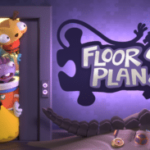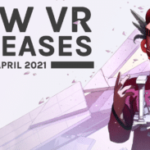Hand Physics Lab is probably the game you want if you’re looking for a hand tracking introduction on Oculus Quest to demonstrate the cutting edge of VR. Read on for our full Hand Physics Lab review to find out why.
The entire collection of puzzles—85 of them in total at launch alongside a sandbox mode—is playable either with hand tracking or Touch controllers. The very first “puzzle”, if you can call it that, is simply to press the button. The big red circle is sitting right there in front of you so just reach out and press it down. But the truth of VR is that when you’re not actually touching real physical objects and have no haptic feedback whatsoever, even something as simple as “press the button” is not necessarily doable on the very first try.
“You mean I actually have to, um, move my hands?” Some people trying VR for the first time will have to learn that. “And you mean I have to push my hand down with a little force in mid-air after positioning it right above the button?” Yes, and even if you’ve owned several VR headsets at this point that’s still a lesson you might need to learn with your bare hands.
So follows dozens of puzzles built by Dennys Kuhnert at Holonautic Studio exploring the very cutting edge of physics-laden open air interaction design.
Pushing through the entire puzzle collection is as maddening as it is interesting. For example, a couple puzzles put you in control of a remote control car you operate by pinching together your fingers in one hand to accelerate the tiny vehicle and wagging a finger left or right on the other hand to direct which way it turns. It’s an absolute joy to realize “whoa this works!” But then, a later puzzle requires driving the car over ramps to your right and left. So you turn your head away from your hands to look, but this moves the headset’s cameras away from your fingertips—effectively destroying your remote control in the process.
Oops, stupid head.
While most puzzles can be satisfyingly solved in seconds, I spent probably an hour on a single puzzle in which I’d convinced myself there was some mystical power in my fingertips that I needed to master. My hands weren’t allowed to penetrate a force field but I’d been empowered with telekinesis to move blocks on the other side of it. I’d come to believe that carefully precise movement and spacing between my fingertips would master the telekinesis like Wanda Maximoff, and allow me to sort the colored blocks into the correct cups on the far end of the table.
Instead, I would again and again either drop the blocks behind the cups, where I couldn’t retrieve them, or pull the blocks into the grip of my hand. It was one of the only puzzles in the collection where I grabbed my Touch controllers to solve it and, with Touch controllers in hand, the puzzle was solved very quickly.
Hand Physics Review – Final Verdict
Hand Physics Lab can be intensely frustrating but also incredibly satisfying. It is also a one-of-a-kind experimental playground that’s unlike anything else Facebook has allowed into the Oculus Quest Store. We recommend grabbing the game to explore the cutting edge of VR game design with hand tracking or controller-based interactions. Its earliest puzzles can be a wonderful introduction to new VR users while its later puzzles — particularly those with mirrored hands — can be revelatory for more experienced VR fans interested in something that scratches an itch for a Portal-like game in VR.


For more on how we arrived at this score, read our review guidelines. This review was conducted using a complimentary early copy provided by the developer on a Quest 2 headset.

Hand Physics Lab is out now on Oculus Quest for $10.







